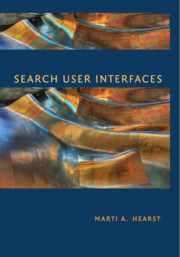Book contents
- Frontmatter
- Contents
- Preface
- 1 The Design of Search User Interfaces
- 2 The Evaluation of Search User Interfaces
- 3 Models of the Information Seeking Process
- 4 Query Specification
- 5 Presentation of Search Results
- 6 Query Reformulation
- 7 Supporting the Search Process
- 8 Integrating Navigation with Search
- 9 Personalization in Search
- 10 Information Visualization for Search Interfaces
- 11 Information Visualization for Text Analysis
- 12 Emerging Trends in Search Interfaces
- Appendix: Additional Copyright Notices
- Bibliography
- Index
- Author Index
- Plate section
7 - Supporting the Search Process
Published online by Cambridge University Press: 05 March 2013
- Frontmatter
- Contents
- Preface
- 1 The Design of Search User Interfaces
- 2 The Evaluation of Search User Interfaces
- 3 Models of the Information Seeking Process
- 4 Query Specification
- 5 Presentation of Search Results
- 6 Query Reformulation
- 7 Supporting the Search Process
- 8 Integrating Navigation with Search
- 9 Personalization in Search
- 10 Information Visualization for Search Interfaces
- 11 Information Visualization for Text Analysis
- 12 Emerging Trends in Search Interfaces
- Appendix: Additional Copyright Notices
- Bibliography
- Index
- Author Index
- Plate section
Summary
Chapter 3 discussed the various theories associated with the information seeking process, and the subsequent chapters described interfaces for supporting query specification, results presentation, and query reformulation – the standard stages of the search process. This chapter describes interface ideas for other aspects of the search process: search starting points, search history, and interfaces that support the process as a whole. The final section discusses attempts to integrate search into the sensemaking process.
Starting Points for Search
The first step in addressing an information need is deciding which tools to use and which collections to search over, a process which is sometimes referred to as source selection. Today there are many choices, including phoning, emailing, or texting a friend, reaching for a physical book, going to a physical library, or sitting down at a networked computer and starting up a Web browser.
Starting Points in Web Search
For those who go online, today the most common starting point is to open a Web browser and start with a Web search engine. Today, Web browsers make that choice even easier by including an always-visible entry form in the browser's “chrome” or by supporting search directly in what used to be the address entry form. But people also commonly start searches from favorite information resources, such as bookmarked Web sites (Teevan et al. 2004). Web browsers have always allowed users to retain bookmarks, but today are making site revisitation even easier by showing usage history as a drop-down menu within the address bar, and matching that history as the user types.
- Type
- Chapter
- Information
- Search User Interfaces , pp. 157 - 173Publisher: Cambridge University PressPrint publication year: 2009



